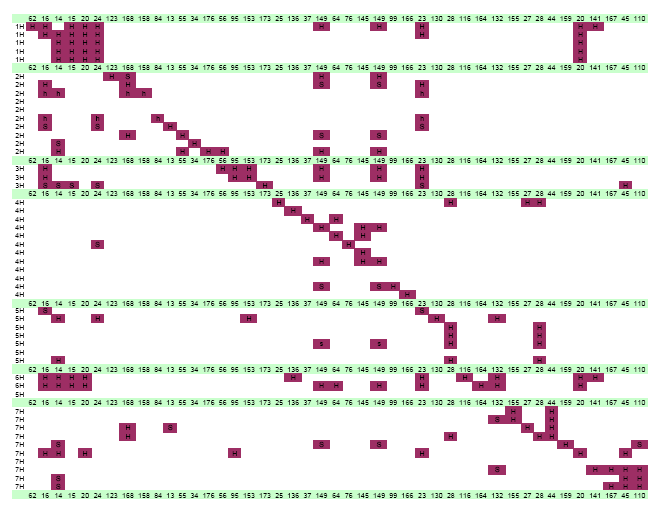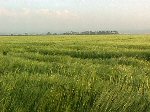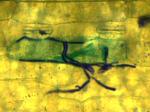Organisation - IPK |
|
|
|
|
|
The Institute of Plant Genetics and Crop Plant Research (IPK) was founded on January 1, 1992. It is a member of the Scientific Association Gottfried Wilhelm Leibniz (WGL, link to WGL). Its forerunner was the (Zentral-)Institut für Genetik und Kulturpflanzenforschung of the GDR, originally the Institut für Kulturpflanzenforschung of the Kaiser-Wilhelm-Gesellschaft, founded in 1943 by Hans Stubbe near Vienna. Currently, more than 450 people work at the IPK including approximately 160 scientific staff.
Founded in 1997, the Plant Genome Resources Center (PGRC) represents a scientific and technological platform for plant genome analysis in barley (Hordeum vulgare) and other crop species at the IPK. A central unit offers services for automated DNA sequencing and high throughput arraying, develops bioinformatic tools and provides user support in the field of bioinformatics.
Research relevant to BarleyGenomeNet (selection)GABI-SEED II: Barley as a model and a crop: gene expression networks determining seed traits (W. Weschke, U. Wobus, M. S. Röder, IPK)In a concerted action of several groups at the IPK the genetic factors underlying seed development are dissected by various approaches within the project GABI-Seed II. Seed development is triggered and controlled by environmental factors as humidity and temperature as well as by genetical factors. To investigate the genetics of seed development transcription factors are of special interest because they exert their control at different levels and biochemical networks. In a first step transcription factors and kinases were selected that putatively are involved in seed development by the group 'Gene expression' at the department of molecular genetics. We currently develop SNP and fragment length polymorphism markers for these loci that will be integrated in existing saturated linkage maps of barley (Steptoe/Morex, Oregon Wolfe barleys). The inferred locus ordering will then be used to characterise 44 BC3 doubled haploid lines between a Hordeum spontaneum donor line and the spring barley cultivar 'Brenda'. This population serves as the base material for transcriptome, proteome and metabolite profiling at four different time points after fertilisation. The analyses are conducted by the groups 'Gene expression', and 'Applied biochemistry' at the IPK. In the combined analysis of expression profiling of RNA, proteins and metabolites with QTL (quantitative trait locus) analysis each profile will be treated as a quantitative phenotype. With the approach termed 'genetical genomics' (Jansen and Nap 2001) we plan to map QTLs that affect the expression profiles either as cis- or as trans-acting factors and to unravel the genetic networks underlying seed development.
Molecular basis of bymovirus resistance in barley - detailed analysis of the resistance locus rym4/5 (N. Stein, A. Graner, IPK)The soil-borne yellow mosaic disease caused by different isolates of the bymoviruses Barley mild mosaic virus (BaMMV) and Barley yellow mosaic virus (BaYMV, BaYMV-2) is an important threat of winter barley production in Central Europe and large parts of East Asia. Several mainly recessive resistance genes have been localised on at least five independent loci within the barley genome with the Rym4/Rym5 locus (chromosome 3HL) representing the most important source of resistance utilized so far in breeding programmes. Recently, we isolated the gene rym4/5 from chromosome 3HL by a classical map-based cloning approach. A 600 kb BAC contig was established that covered the gene Hv-eIF4E coding for the eukaryotic translation initiation factor 4E (eIF4E). This gene is also called 'cap-binding protein, since its host function is binding the m7G-cap structure of mature eukaryotic mRNAs and thus initializes the translation process. Homologs of this gene have been shown previously to be involved in potyvirus resistance in pepper, lettuce, Arabidopsis and melon but so far not in any monocot species. Complementation of a resistant barley cultivar via stable transformation with a putative susceptibility allele of the gene led to induction of susceptibility to BaMMV and BaYMV-1, thus confirming the role of the gene in controlling resistance to bymoviruses in barley. Comparative sequencing in diverse barley genotypes allowed the determination of a number of rym4/5-diagnostic single nucleotide polymorphisms (SNPs) in four exons of the gene. All of them induced AA-changes and modeling of the predicted 3D-structure of the protein revealed that all polymorphisms allocated in proximity of the CAP-binding domain of the protein (Fig. 1). This domain of eIF4E was shown to be also involved in interaction to the viral protein VPg in Arabidopsis indicating that Hv-eIF4E and bymovirus VPg interaction maybe necessary for the establishment of virus infection through replication, translation or translocation in barley.
Currently we are extending our analyses mainly into three directions: (i) Elucidation of the resistance mechanism to determine whether a direct interaction of Hv-eIF4E and bymovirus VPg is essential for establishing susceptibility; (ii) Assessing natural genetic diversity in the gene Hv-eIF4E to harness new allelic diversity for resistance breeding; (iii) Candidate gene-based isolation of further resistance genes based on the knowledge that additional proteins of the translation initiation complex can directly interact with plant viral proteins in other plant/virus systems. GABI-NONHOST: A consortium-based functional genomics initiative on plant nonhost disease resistance (P. Schweizer, IPK in cooperation with BASF Plant Science)Barley is one of the most important feed and food crops worldwide. Despite its agronomic importance and excellent, available genetic resources, tools for genome-wide analysis of barley have only recently been initiated and include high-resolution genetic maps, physical gene mapping, highly efficient protocols for genetic transformation, insertion mutagenesis, TILLING platforms, a large EST collection as well as gene arrays for expression profiling. We have contributed to extending this genomics toolbox in barley by establishing 22,000 EST sequences from powdery mildew-attacked barley epidermis, a 10K cDNA array as well as a high-throughput RNAi system for assessing gene function in attacked barley epidermal cells. The RNAi system for transient-induced gene silencing (TIGS) based on biolistic transgene delivery is being used to study the function of approximately 900 barley candidate genes including 693 up-regulated genes, 101 resistance-gene analogues expressed in barley epidermis as well as 58 proteasome component genes. The library of RNAi constructs was built up by a new, cost-efficient method that combines highly efficient ligation and recombination by the GATEWAY cloning system into a final RNAi destination vector that was found to direct highly efficient RNAi. The full RNAi construct library was tested in a TIGS screening for breakdown of nonhost resistance against wheat powdery mildew. Approximately 200 up-regulated host genes were also tested for breakdown of mlo-mediated host resistance or modulation of host susceptibility. Forty-three candidate genes producing a susceptible or resistant phenotype in one or several of the first-round TIGS screening are being analyzed in greater detail.
Selected publications:Douchkov D, Nowara D, Zierold U, and Schweizer P (2005) A high-throughput gene silencing system for the functional assessment of defense-related genes in barley epidermal cells. Molecular Plant-Microbe Interactions 18: 755-761. Jansen, R. C. and J.-P. Nap (2001) Genetical genomics: the added value from segregation. Trends in Genetics 17: 388-391. Pellio, B., Streng, S., Stein, N., Perovic, D., Schiemann, A., Friedt, W., Ordon, F. and Graner, A. (2005) High-resolution mapping of the Rym4/5 locus conferring resistance to the Barley yellow mosaic virus complex (BaMMV, BaYMV, BaYMV-2) in barley (Hordeum vulgare ssp. vulgare L.). Theor. Appl. Genet., 110, 283-293. Stein, N., Perovic, D., Kumlehn, J., Pellio, B., Stracke, S., Streng, S., Ordon, F. and Graner, A. (2005) The eukaryotic translation initiation factor 4E confers multiallelic recessive bymovirus resistance in Hordeum vulgare (L.). The Plant Journal, accepted for publication. Wicker, T., Zimmermann, W., Perovic, D., Paterson, A.H., Ganal, M., Graner, A. and Stein, N. (2005) A detailed look at 7 million years of genome evolution in a 439 kb contiguous sequence at the barley Hv-eif4e locus: Recombination, re-arrangements and repeats. The Plant Journal, 41, 184-194. For more details, please visit the institute's website (http://www.ipk-gatersleben.de). |
|
Barley Genome Net - Organisation - IPK |
|
|
|
|
|
|
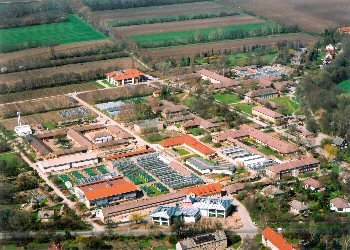 The objective of the Institute is to carry out basic and applied research
on crop plants in the tradition of its predecessor institutions with special
emphasis on genetics and genomics. In accordance with Institute statutes,
its research focuses on structure, function and evolution of genomes as well as
on conservation and evaluation of the genetic diversity of crop plants,
of their progenitors and relatives.
The objective of the Institute is to carry out basic and applied research
on crop plants in the tradition of its predecessor institutions with special
emphasis on genetics and genomics. In accordance with Institute statutes,
its research focuses on structure, function and evolution of genomes as well as
on conservation and evaluation of the genetic diversity of crop plants,
of their progenitors and relatives.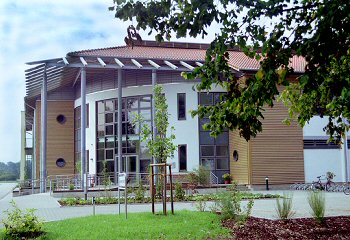 The IPK has largely invested into analysing the expressed part of the
barley genome by setting up an EST (expressed sequence tag) project within
The IPK has largely invested into analysing the expressed part of the
barley genome by setting up an EST (expressed sequence tag) project within
